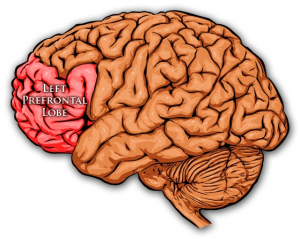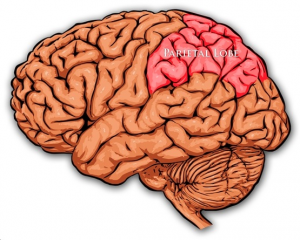Meditation and the Physical Transformation of the Brain: Part II
In this series we will be looking at four key structures in our brains that change as a result of long-term meditation:
- the thalamus,
- the left prefrontal cortex,
- the parietal lobe, and
- the middle prefrontal areas.
You can read about the implications of changes that occur in the thalamus in my previous blog Meditation and the Physical Transformation of the Brain: Part I. Here I will discuss the implications of the correlations scientists have discovered between long-term meditation and changes in both the left prefrontal c ortex and the parietal lobe.
ortex and the parietal lobe.
The Left Prefrontal Cortex
The left prefrontal cortex is the part of your brain that’s directly behind the forehead and to the left, just above your left eye. In advanced meditators, we find that there is a greater degree of specific activity in this part of the brain than in the brains of people who do not meditate. Heather Urry and colleagues did a study a few years back where they correlated this greater activity in the left prefrontal cortex with what they defined as eudaimonic well-being. Eudaimonic well-being is a fancy term that describes the sort of well-being correlated with approach-oriented or goal-oriented behaviors; behaviors characterized by leaning into life, and moving towards a positive affirmation and a positive experience of life, rather than moving away from life. These scientists also found that this greater left prefrontal activity correlates with greater levels of equanimity, a sense of balance, harmony, and intrinsic well-being.
With intrinsic well-being, there is the sense that our experiences of pleasure become more subtle. We no longer need to rely so much upon extrinsic stimulation for pleasure; for example, we can still enjoy external stimulation, but our happiness doesn’t become dependent upon it.There’s a sense of an inner pleasure, an inner bliss, an inner sense of fulfillment that comes with this greater left prefrontal activity.
This greater activity in the left prefrontal cortex is also correlated with more positive relationships, a mastery of the environment, as well as a greater sense of personal growth, self-acceptance, and meaning and purpose in life. We can see from this tendency that meditation can therefore develop the part of our brain that helps us experience more contentment from our own inner sense of being, our essence.
The Parietal Lobe
Another structural change that often occurs in long-term meditators are shifts in the activity of the parietal lobe. The parietal lobe helps mediate a sense of relationship between self and other. It also mediates a sense of space as well as the position of our bodies in space. Whenever there is any kind of activity going on where we’re relating to someone else or we’re doing some kind of spatial cognitive task that, by definition, has us cognizing space and working with space, the parietal lobes on either side of the brain will light up.
When Not Meditating
What we find in advanced meditators is that even when they’re not meditating, they have higher levels of activity in the parietal lobes. One of the interpretations of this phenomenon states that this greater activity suggests that profound states of meditation strengthen our relationship with the world and our relationship with the spiritual dimensions of life, so that even when we’re not meditating, there is a deep sense of connection with the world around us and a deep sense of connection with that part of ourselves that defies definition and transcends form. This identification is intangible but experienced as being very, very real. The more we become grounded in this sense of connection, the more of this unique activity we see in the parietal lobes.
Another correlation we’ve seen with increased activity in the parietal lobes is an increase in consciousness: conscious awareness, alertness, and the ability to resonate with the thoughts and feelings of others.
During Meditation
Interestingly, when long-term meditators are engaged in very deep meditation—when there’s a sense of unity and non-dual consciousness, where the subject-object duality collapses and there’s a sense of dissolution of the self and other—what happens is that there is a corresponding decrease of activity in the parietal lobes. The pervasive interior experience is one of infinite, expansive spaciousness, sometimes even including a complete dissolution of body awareness.
So, what we see again is that long-term, advanced practice can help the brain to be able to support higher and higher levels of connection to the world, often resulting in greater degrees of social awareness, inner freedom, and life fulfillment.
Bibliography
Davidson RJ, Kabat-Zinn J, Schumacher J, Rosenkranz M, Muller D, Sanotrelli SF et al. (2004). Alterations in brain and immune function produced by mindfulness meditation. Psychosomatic Medicine, 65(4), 564-570.
Newberg, A. (2009). How God Changes Your Brain: Breakthrough Findings from a Leading Neuroscientist. New York: Ballentine.
Shim YS, Kim JS, Shon YM, Chung YA, Ahn KJ, Yang DW. A serial study of regional cerebral blood flow deficits in patients with left anterior thalamic infarction: Anatomical neuropsychology correlates. J Neurol Sci. 2008 Mar 15;266(1-2):84-91.
Urry HL, Nitschke JB, Dolski I, Jackson DC, Dalton KM, Mueller CJ et al. (2004). Make a life worth living: Neural correlates of well-being. Psychological Science, 15(6), 367-372.
___________________________________________________________________________
 Eric Thompson is a co-founder of iAwake Technologies, LLC and was its Chief Technology Officer. Although no longer with iAwake Technologies, his contributions have been immense. Eric is also an inventor, researcher, and producer, and is considered one of the world’s foremost brainwave entrainment experts. In addition, Eric is a pioneer in the development of biofield entrainment technology, which digitally captures and transmits life-enhancing and beneficial subtle energies to the human biofield via any digital medium, including pictures, audio, and film. By combining this emerging technology with an unconventional, innovative, and original approach to audio brainwave entrainment, Eric strives to make profound spiritual development and emotional freedom more easily accessible to all. He writes and speaks on the intersection between neuroscience, psychology, subtle energy, and spirituality.
Eric Thompson is a co-founder of iAwake Technologies, LLC and was its Chief Technology Officer. Although no longer with iAwake Technologies, his contributions have been immense. Eric is also an inventor, researcher, and producer, and is considered one of the world’s foremost brainwave entrainment experts. In addition, Eric is a pioneer in the development of biofield entrainment technology, which digitally captures and transmits life-enhancing and beneficial subtle energies to the human biofield via any digital medium, including pictures, audio, and film. By combining this emerging technology with an unconventional, innovative, and original approach to audio brainwave entrainment, Eric strives to make profound spiritual development and emotional freedom more easily accessible to all. He writes and speaks on the intersection between neuroscience, psychology, subtle energy, and spirituality.
___________________________________________________________________________
Leave a Comment
You must be logged in to post a comment.

Leave your comments below